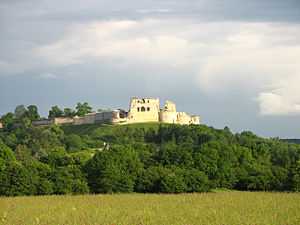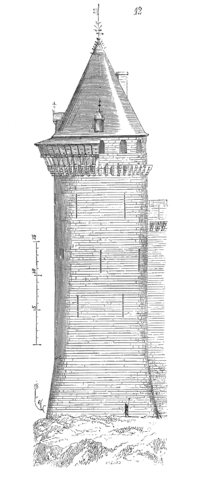Château de Coucy
| Château de Coucy | |
|---|---|
| Coucy-le-Château-Auffrique, Aisne, France | |
 | |
| Château of Coucy, from across the Ailette valley | |
| Type | Medieval castle |
| Site information | |
| Controlled by | french ministry of culture |
| Site history | |
| Built | c. 1220s |
| In use | fortress |
| Built by | Enguerrand III de Coucy |
| Materials | stone |
| Height | 20 meters |
| Events | Coucy a la merveille |
| Garrison information | |
| Occupants | lords of Coucy |


The Château de Coucy is a French castle in the commune of Coucy-le-Château-Auffrique, in the département of Aisne, built in the 13th century and renovated by Viollet-le-Duc in the 19th. In April 1917, the German army dynamited the keep and the four towers using 28 tons of explosives to prevent their use by enemy artillery spotters as the Germans fell back in the region.

During its heyday, it was famous for the size of its central tower and the pride of its lords, who adopted the staunchly independent rhyme: "Roi ne suis, ne Prince ne Duc ne Comte aussi; Je suis le sire de Coucy" ("I am not a King, nor Prince nor Duke nor Count; I am the Lord of Coucy").
The castle was constructed in the 1220s by Enguerrand III de Coucy. The castle proper occupies the tip of a bluff or falaise. It forms an irregular trapezoid of 92 x 35 x 50 x 80 m. At the four corners are cylindrical towers 20 m in diameter (originally 40 m in height). Between two towers on the line of approach was the massive donjon (keep). The donjon was the largest in Europe, measuring 35 meters wide and 55 meters tall. The smaller towers surrounding the court were as big as the donjons being built at that time by the French monarchy. The rest of the bluff is covered by the lower court of the castle, and the small town.[1]

Coucy was occupied in September 1914 by German troops during World War I. It became a military outpost and was frequented by German dignitaries, including Kaiser Wilhelm II himself.[citation needed] In March 1917 the German army destroyed the keep and the 4 towers. It is not known whether this act had some military purpose or was merely an act of wanton destruction. The destruction caused so much public outrage that in April 1917 the ruins were declared "a memorial to barbarity". War reparations were used to clear the towers and to consolidate the walls but the ruins of the keep were left in place.[2]
One of its lords, Enguerrand VII de Coucy (1340–1397) is the subject of historian Barbara Tuchman's study of the fourteenth century, A Distant Mirror. It also features extensively in British author Anthony Price's 1982 crime/espionage novel The Old Vengeful.
Château de Coucy has been listed as a monument historique by the French Ministry of Culture since 1862, and is managed by the Centre des monuments nationaux.
See also
References
- ↑ Charles-Laurent Salch, Dictionnaire des châteaux et des fortifications du moyen-âge en France . Publisher: Editions Publitotal, Strasbourg (France); 1979.
- ↑ the coucy castle
External links
- A description of the castle by Viollet-le-Duc (French)
- Centre des monuments nationaux website
- Ministry of Culture database entry for Château de Coucy (French)
- Ministry of Culture photos
- Collection of old postcards from Coucy (French)
| Wikimedia Commons has media related to Château de Coucy. |